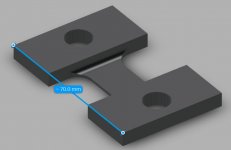EN24 817M40 4340 ASTM A29 tough stock with a rough finish
What would you recommend, indexable tips or carbide? this is the part I need to machine, by the 100s:

6mm (0.236) thick from 8mm (0.315) stock, faced both sides
mid recess has a 3mm (0.118) rad
currently using tips but they bang alot on this tough material like it needs a keener edge, probably have stay with tips for the facing - 45mm (1.770) wide cut but thinking about carbides for the sides and recess?
cheers,
....
What would you recommend, indexable tips or carbide? this is the part I need to machine, by the 100s:

6mm (0.236) thick from 8mm (0.315) stock, faced both sides
mid recess has a 3mm (0.118) rad
currently using tips but they bang alot on this tough material like it needs a keener edge, probably have stay with tips for the facing - 45mm (1.770) wide cut but thinking about carbides for the sides and recess?
cheers,
....


